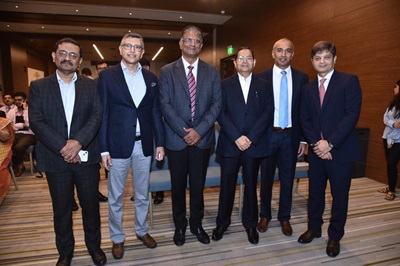The Gem and Jewellery Export Promotion Council (GJEPC) recently hosted an interactive session with leading bankers in Mumbai on October 17, focusing on the current industry outlook and exploring new opportunities for collaboration with financial institutions

The Gem and Jewellery Export Promotion Council (GJEPC) organized an interactive session with prominent bankers in Mumbai on October 17 to discuss the current industry landscape and explore opportunities for deeper collaboration with financial institutions. Over 75 attendees participated in the event, which opened with an address emphasizing the critical role of banking partnerships in fostering the growth of the gem and jewellery sector.
The session highlighted the need for continued support from banking partners, especially during these challenging times. Discussions focused on strengthening the relationship between the industry and financial institutions, addressing mutual concerns, and identifying solutions to the financial hurdles hindering sector growth. The event underscored the importance of joint efforts in ensuring a stable and prosperous future for both sides.
The keynote address provided an in-depth analysis of the industry's current challenges, including declining demand in key markets like the USA and China, as well as the impact of geopolitical tensions on trade. Despite these obstacles, the resilience of the Indian gem and jewellery industry was highlighted, with growth opportunities in the Middle East, backed by the India-UAE CEPA agreement, receiving particular attention. The address also touched upon recent government policies, GJEPC’s advocacy for the industry's needs, and the importance of robust banking partnerships to navigate financial difficulties and drive future growth.
GJEPC called on the government to reconsider the Rs. 50 lakh cap on the Interest Equalization Scheme for MSMEs, arguing that it fails to meet the financial requirements of the gem and jewellery sector, which operates with high-value, low-margin exports and extended working capital cycles. The Council has requested an extension of the scheme's benefits until March 2026 to provide businesses with much-needed stability.
Industry expert Pranay Narvekar, Partner at Pharos Beam Consulting LLP, provided an overview of the diamond industry, highlighting potential opportunities, challenges, and the critical role of banking in supporting its growth. He noted that, while the sector has faced recent difficulties, factors such as recovering retail diamond demand, the impact of lab-grown diamonds, and improving supply chain efficiency will shape the future. He emphasized that despite fluctuations, the industry's financial health has improved, making it essential for both businesses and bankers to understand these dynamics.
Niraj Shah, Country Head of Corporate and Institutional Banking at IndusInd Bank, offered a banker’s perspective, noting that the gem and jewellery industry holds significant potential but requires a collaborative approach. He emphasized the need for innovation, sustainability, and ethical practices to overcome current challenges and create a more resilient and competitive future.
A panel discussion featuring industry leaders and bankers provided a platform for open dialogue, focusing on the current state and future prospects of the Indian diamond and jewellery industry. Participants agreed that the sector has weathered challenges in the past and is expected to recover within the next 1-2 years. The discussion also touched on emerging opportunities in new markets and different segments of the industry.
Key takeaways from the panel included the recognition of the industry's resilience, with speakers pointing to its history of overcoming challenges such as the COVID-19 pandemic and market corrections. Banks expressed optimism, emphasizing individual company assessments rather than broad negative views. Additionally, the industry’s cyclical nature was acknowledged, with the panel noting that certain segments, such as small diamonds, have performed well despite the overall downturn.
In the Q&A session, it was revealed that the Export Credit Guarantee Corporation of India Limited (ECGC) is considering GJEPC’s request to raise the credit guarantee limit for bankers beyond the current Rs. 100 crore cap.
The session concluded with a summary that reinforced GJEPC’s commitment to maintaining open communication channels and fostering stronger ties between the gem and jewellery industry and the banking sector. The industry is on a path to recovery, with initiatives aimed at boosting demand and fostering growth. India, a key player in the midstream segment of the global supply chain, is at the forefront of these efforts. GJEPC is collaborating with De Beers and the Natural Diamond Council on the generic promotion of diamonds and diamond jewellery and partnering with the World Gold Council to promote gold jewellery. A large consumer campaign, supported by GJEPC, is also underway to strengthen diamond jewellery demand.
The event concluded with the optimistic note that the industry is expected to recover by the first quarter of 2025-26, bolstered by China’s fiscal stimulus measures and the planned expansion of over 3,000 jewellery retail stores across India in the next three years.
Be the first to comment